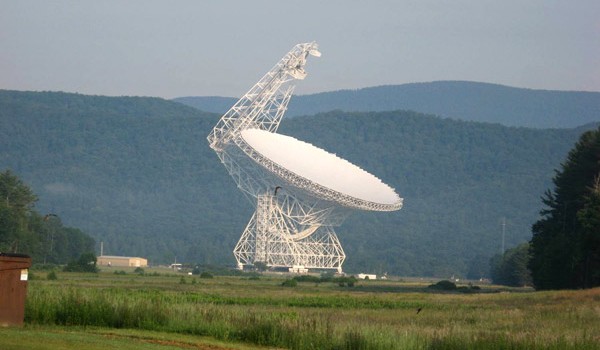GREEN BANK, W.Va. — There’s a sigh of relief coming out of Pocahontas County almost as large as the massive Green Bank Telescope. The National Science Foundation has entered a record of decision that says it will continue to support the operation of the massive telescope and the Green Bank Observatory where it’s located.
The review of the future of Green Bank began back in 2012 when the NSF initially recommended it be divested for newer scientific facilities but as the review process continued, Green Bank Observatory Director Karen O’Neil said, it became clear the facility would be key in the advancement of scientific studies for years to come.

“When the review began the GBT (Green Bank Telescope) was only about 10 years old so that worked in our favor,” O’Neil told MetroNews Tuesday. “They (NSF) want to keep the facility open and want to remain a partner with any additional partners that we might find in order to cut back on the budget that the NSF has to put into the facility while still recognizing the GBT puts forth amazing science and the Green Bank Observatory actually has great educational programs as well.”
O’Neil said it was tough at times to have to wait several years for a decision but in the end she believes the lengthy review helped Green Bank.
“Seven years is a very long time to be going through this process but had we sped it up the alternative might have been very different. So I’d much rather take our time and come forward with a great path like we did than to try and hurry it up and not find good alternatives,” O’Neil said.
U.S. Senator Joe Manchin said Tuesday he was able to include provisions in the 2018 federal spending plan preventing NSF from divesting itself from its facilities while encouraging it to find partners to help with funding.
“For 60 years the Foundation, Pocahontas County, and the state of West Virginia have supported the ability of innumerable national and international scientists to make discoveries about our Universe using the capabilities located at the Observatory within the National Quiet Zone. Over this time, the local communities have made sacrifices to keep the surrounding area radio-silent to ensure that the activities at the Observatory can continue without interference. As we look to the future, I believe that the Observatory’s contributions to national and international science and the West Virginia commitment to this work justifies the Foundation’s strong, continued full-time support and presence at the Observatory,” Manchin said.
O’Neil said funding assistance outside of NSF will be a key moving forward.
“The NSF is looking for additional partners to try and continue to reduce the amount of funding they have to put into it but they have noted that they find the value of the Green Bank Observatory at the GBT to be extremely high,” she said.
NSF funds approximately 65 percent of the observatory’s annual $14 million budget.
GOOD NEWS: the @GreenBankObserv in Pocahontas County will remain open! I’m proud to have worked with @NSF to ensure this facility can continue to enable national and international scientists to make important discoveries about our Universe ? pic.twitter.com/mew75WYevC
— Senator Joe Manchin (@Sen_JoeManchin) July 30, 2019
There have been strong indications the decision announced Tuesday would be coming. The NSF announced last year plans to spend $1.3 million to further update the GBT so it can measure surface distortions any time during the day or night, increasing the hours when information from the telescope can be used. O’Neil said those are the kind of updates that made her optimistic a favorable decision would eventually be the result of the review.
“There’s been a lot of public meetings where the NSF has openly said this is the alternative they preferred but it’s one thing to know it’s preferred and another thing to get it down in writing and know you have it done,” she said.
The NSF is now starting to work again with the scientific community or what studies will be needed in the next 10 years. O’Neil said early indications are the GBT will play a key role during the coming decade.
The observatory, which was established in 1957 as the National Radio Astronomy Observatory (NRAO). It currently has 105 year round employees and another 40 that are hired for the summer months.
Former U.S. Senator Robert Byrd secured funding for the 100-meter telescope that’s the featured instrument at the facility. It went into operation in 2003. O’Neal said she’s glad Byrd’s legacy will continue.
“I think the senator would be pleased with this,” she said.
The National Science Foundation is a federal agency. It contracts with AUI, Associated Universities, Inc., to manage the facility.

